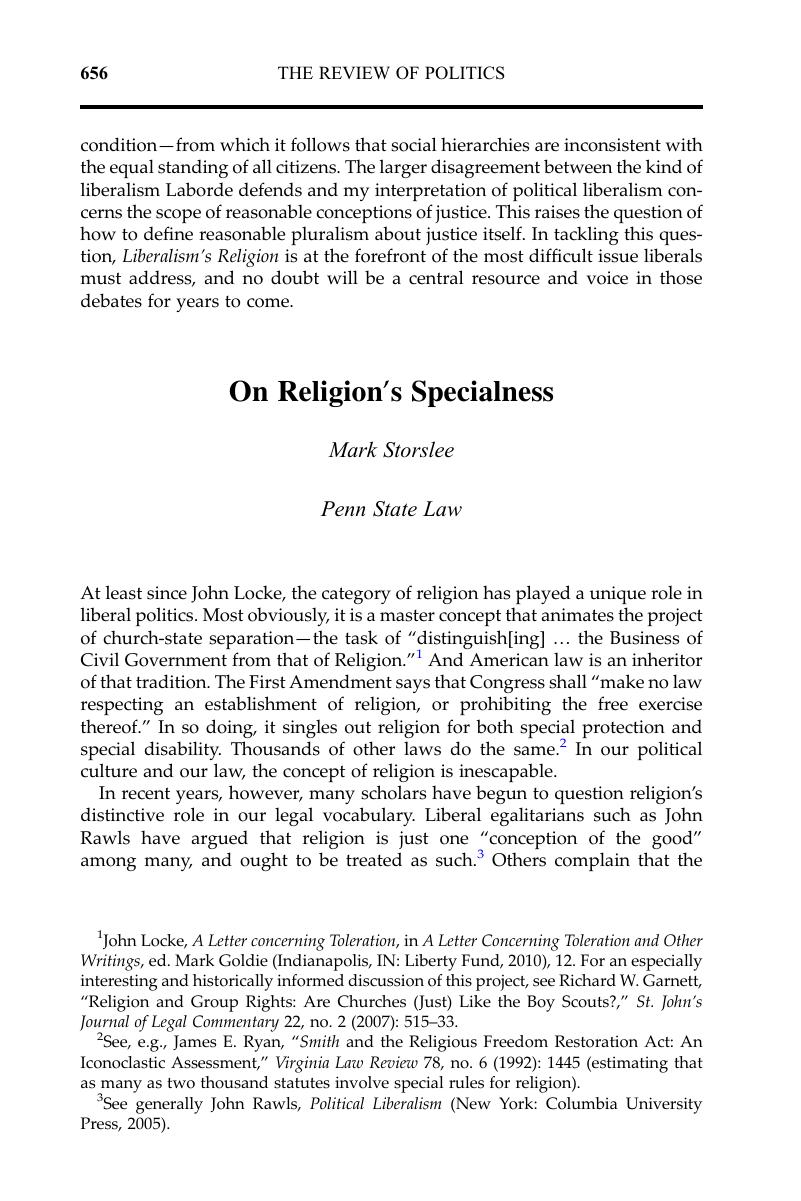No CrossRef data available.
Article contents
On Religion's Specialness - Cécile Laborde: Liberalism's Religion. (Cambridge, MA: Harvard University Press, 2017. Pp. 344.)
Published online by Cambridge University Press: 11 September 2019
Abstract

- Type
- A Symposium on Cécile Laborde's Liberalism's Religion
- Information
- Copyright
- Copyright © University of Notre Dame 2019
References
1 Locke, John, A Letter concerning Toleration, in A Letter Concerning Toleration and Other Writings, ed. Goldie, Mark (Indianapolis, IN: Liberty Fund, 2010), 12Google Scholar. For an especially interesting and historically informed discussion of this project, see Garnett, Richard W., “Religion and Group Rights: Are Churches (Just) Like the Boy Scouts?,” St. John's Journal of Legal Commentary 22, no. 2 (2007): 515–33Google Scholar.
2 See, e.g., Ryan, James E., “Smith and the Religious Freedom Restoration Act: An Iconoclastic Assessment,” Virginia Law Review 78, no. 6 (1992)CrossRefGoogle Scholar: 1445 (estimating that as many as two thousand statutes involve special rules for religion).
3 See generally Rawls, John, Political Liberalism (New York: Columbia University Press, 2005)Google Scholar.
4 See, e.g., Cavanaugh, William T., The Myth of Religious Violence: Secular Ideology and the Roots of Modern Conflict (Oxford: Oxford University Press, 2009)CrossRefGoogle Scholar, 16 (arguing that the category of religion was designed to “delegitimate[] certain kinds of violence” while “legitimating … violence done in the name of secular, Western ideals”).
5 See Lund, Christopher C., “Religion Is Special Enough,” Virginia Law Review 103 (2017): 496–97Google Scholar (surveying these arguments).
6 To be sure, one might also ask what makes “conscience” special. For an interesting discussion of this question, see Smith, Steven D., “The Tenuous Case for Conscience,” Roger Williams University Law Review 10, no. 2 (2005)Google Scholar.
7 See, e.g., Leiter, Brian, Why Tolerate Religion? (Princeton: Princeton University Press, 2013), 34–53Google Scholar (arguing that religion is marked by “categoricity of commands” and “insulation from reasons and evidence”).
8 Locke, Letter concerning Toleration, 21. Andrew Koppelman has made a similar argument, insofar as he has suggested that the category of religion is a “proxy” for goods that cannot be “targeted directly.” See Koppelman, Andrew, “Religion's Specialized Specialness,” University of Chicago Law Review Online 79, no. 1 (2013): 78Google Scholar. Unlike Koppelman, however, my argument is that the category of religion identifies a phenomenon that is more than and distinct from any of its constituent parts, not just a convenient substitute for them. On this score, my argument has more in common with Founding-era arguments—which almost always invoked religion's multifaceted character—than it does with Koppelman's theory. See, e.g., Laycock, Douglas, “Religious Liberty as Liberty,” Journal of Contemporary Legal Issues 7 (1996): 316–19Google Scholar (discussing pluralist arguments about religion made by the founding generation); McConnell, Michael W., “The Problem of Singling Out Religion,” DePaul Law Review 50 (2000): 16–31Google Scholar (same).
9 406 U.S. 205 (1972).
10 Ibid., 216.
11 See, e.g., Marshall, William P., “In Defense of Smith and Free Exercise Revisionism,” University of Chicago Law Review 58 (1991): 319–20CrossRefGoogle Scholar.
12 494 U.S. 872 (1990).
13 See also Garrett Epps, “Elegy for a Hero of Religious Freedom,” The Atlantic, Dec. 9, 2014, https://www.theatlantic.com/politics/archive/2014/12/elegy-for-an-american-hero-al-smith-smith-employment-division-supreme-court/383582/ (recounting the story behind Al Smith's decision to attend the peyote ceremony at issue in Smith).
14 See Smith, 494 U.S. at 903 (O'Connor, J., concurring in the judgment).
15 See Epps, “Elegy” (noting that “To the white people who ran the agency” where Smith worked, “peyote was not a religious exercise—it was an ‘illegal drug’”).
16 See Eisgruber, Christopher L. and Sager, Lawrence G., Religious Freedom and the Constitution (Cambridge, MA: Harvard University Press, 2007), 92CrossRefGoogle Scholar (explaining these exemptions for sacramental wine).
17 See Leiter, Why Tolerate Religion?, 96 (pointing out similarities between religion and veganism); Schwartzman, Micah, “What If Religion Is Not Special?,” University of Chicago Law Review 79 (2013): 1422Google Scholar (arguing that utilitarianism ought to be limited the same way as religion for purposes of governmental endorsement).
18 For more on concepts and the ways that their application always involves “family resemblances” rather than uniform criteria, see Wittgenstein, Ludwig, Philosophical Investigations, trans. Anscombe, G. E. M. (New York: Macmillan, 1958), 31–35Google Scholar.
19 134 S. Ct. 2751 (2014).
20 See Planned Parenthood of Southeastern Pennsylvania v. Casey, 505 U.S. 833, 851 (1992).
21 See Hobby Lobby, 134 S. Ct. at 2763–64 (explaining the differing regulatory regimes).
22 For a perceptive discussion of the affinities between religion and sexual orientation, see Eskridge, William N. Jr., “A Jurisprudence of ‘Coming Out’: Religion, Homosexuality, and Collisions of Liberty and Equality in America,” Yale Law Journal 106 (1997): 2416–30CrossRefGoogle Scholar.


